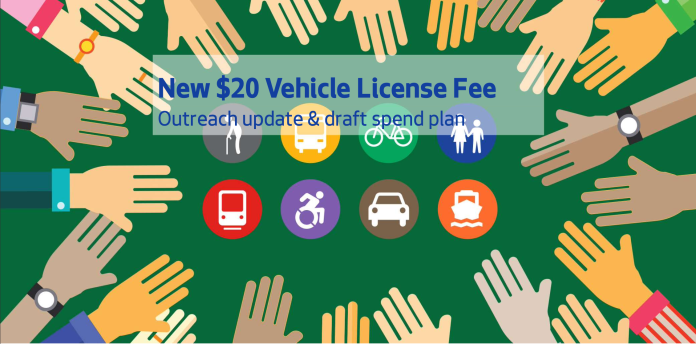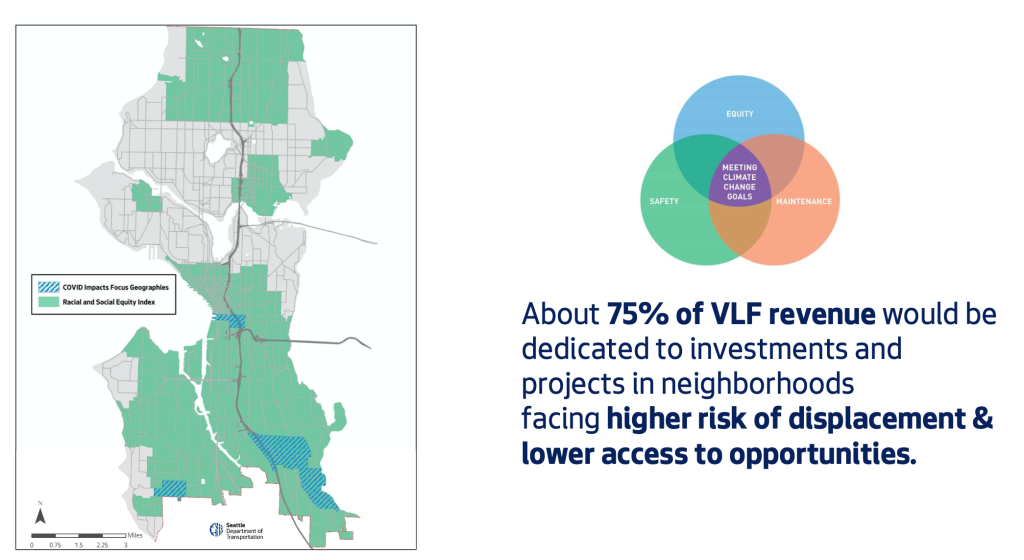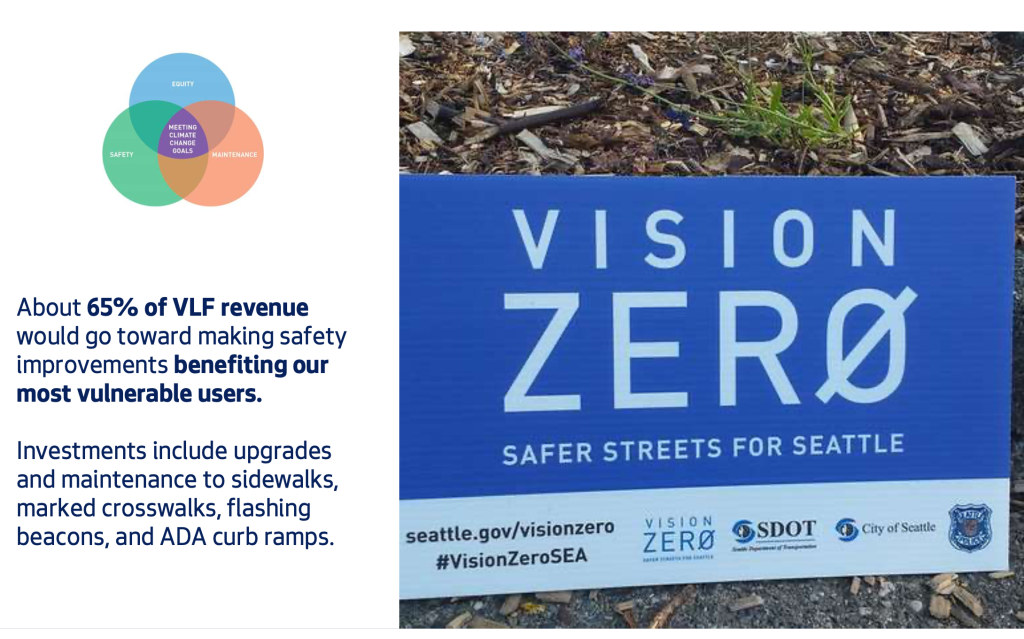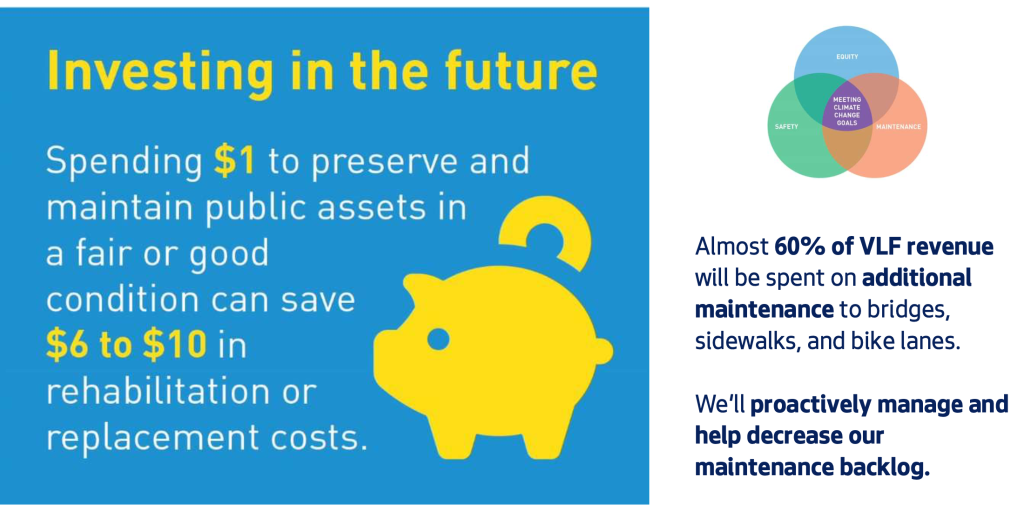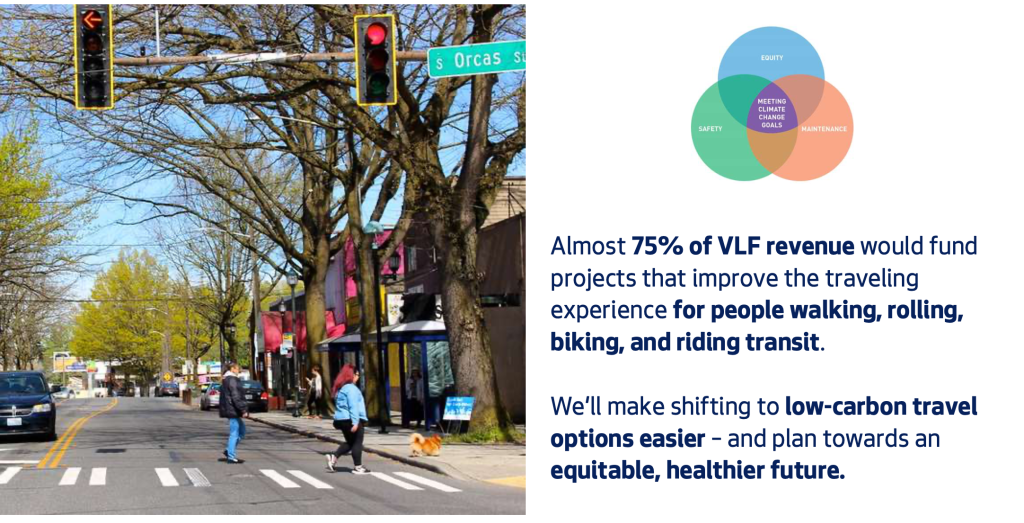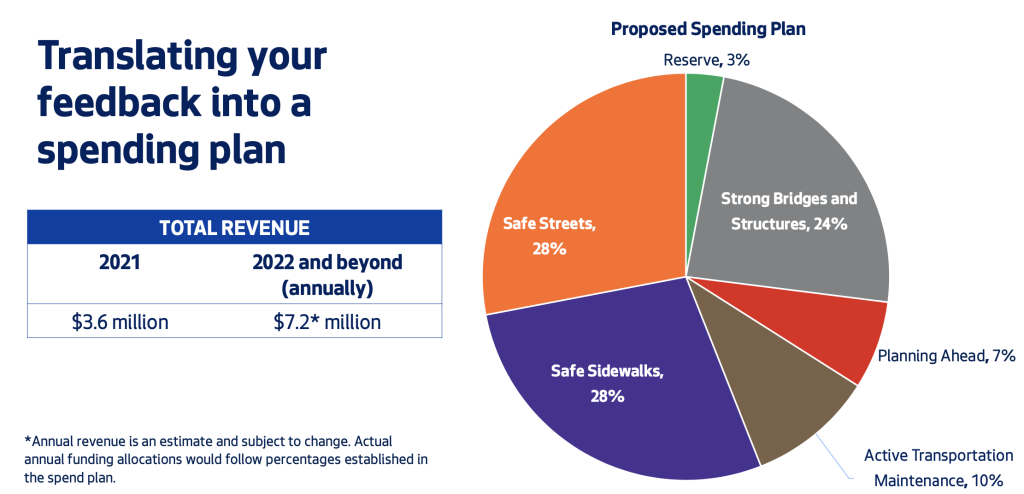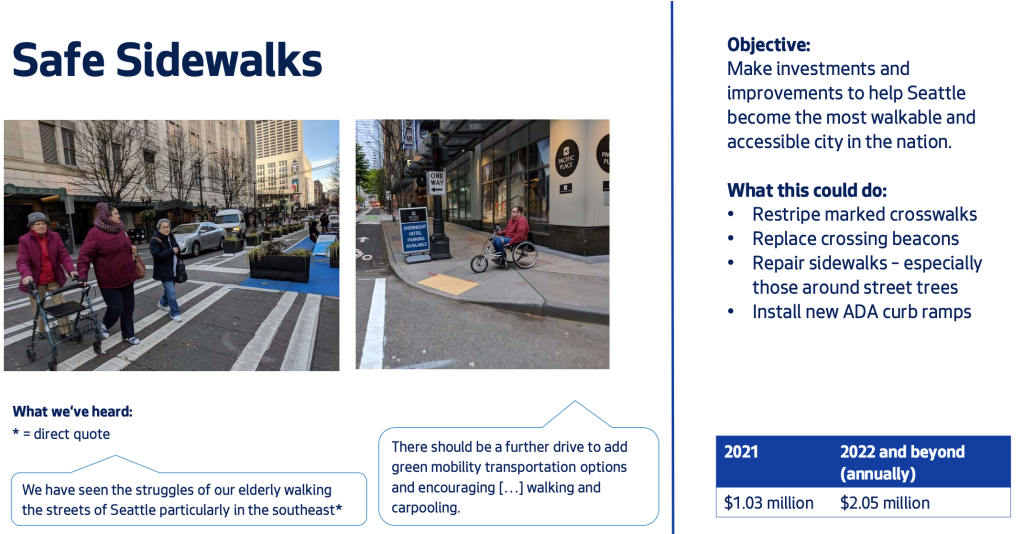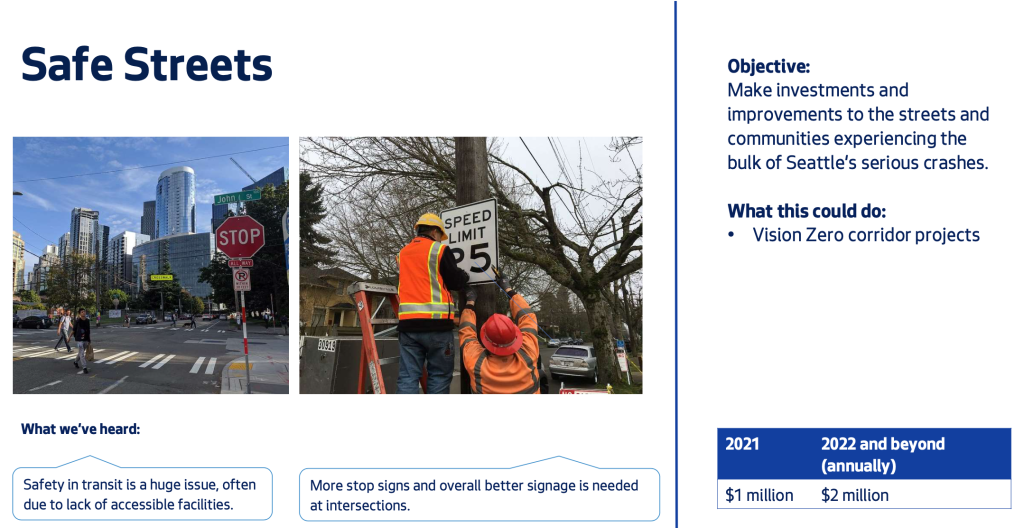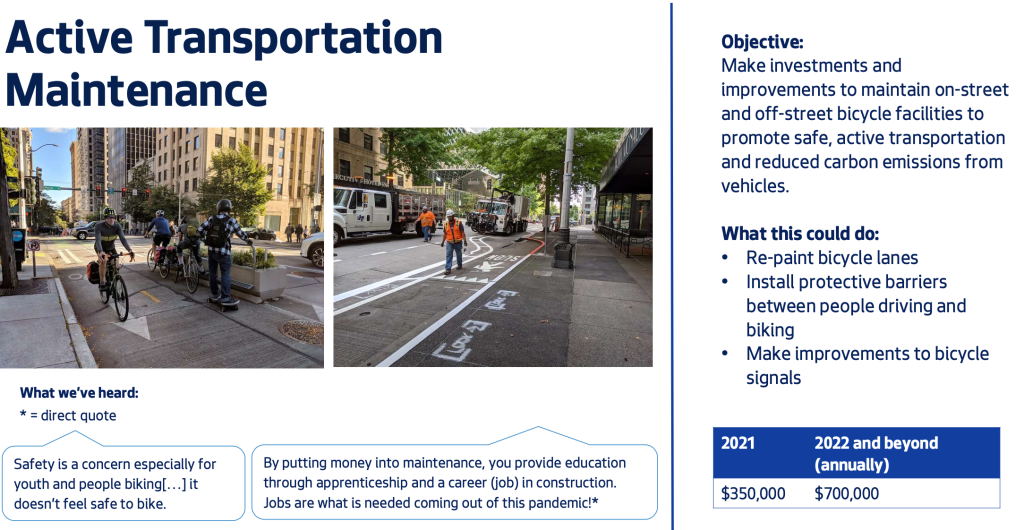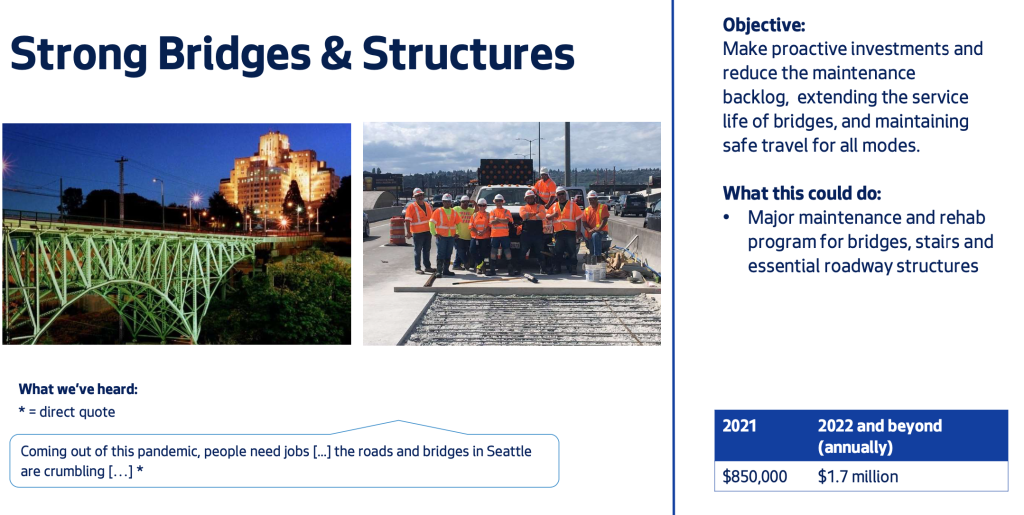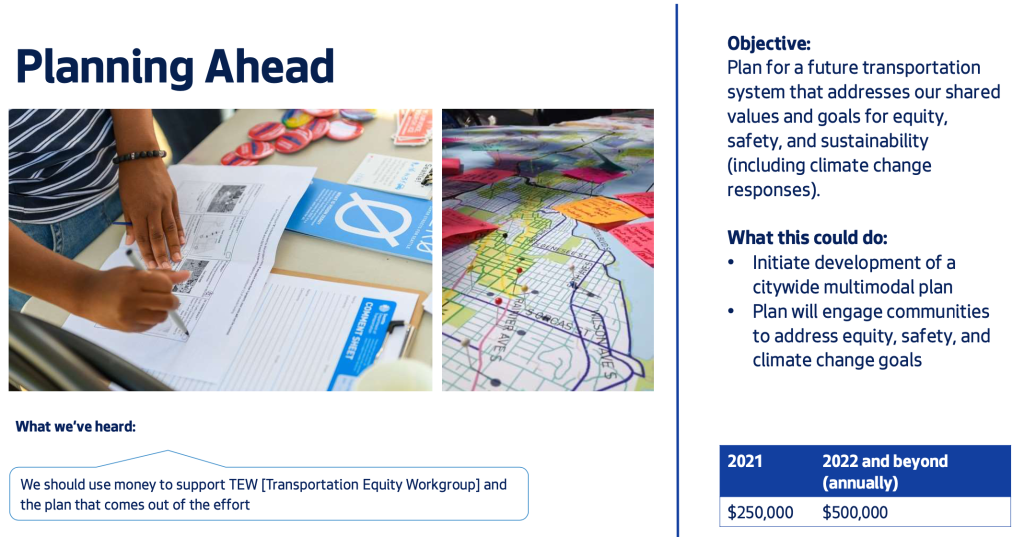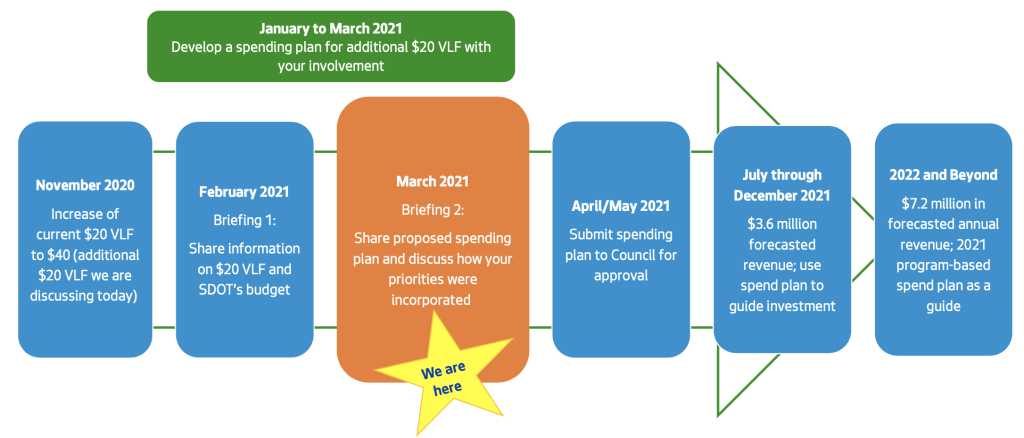Details of how a new $20 vehicle licensing fee (VLF) in Seattle that could raise $7.2 million per year would be used for transportation investments are beginning to emerge. An exact spending plan has yet to be finalized by the Seattle Department of Transportation (SDOT), but the agency has outlined the general priority areas where money could go and is seeking feedback from key stakeholders in developing a proposal that will be transmitted to the city council next month. Adoption of a final plan could then come in April or May.
Guiding values and goals
SDOT’s values for the spending plan are overlapping equity, safety, and maintenance goals with an emphasis on meeting climate change goals. At a programmatic level, the department has identified a handful of buckets for investment that reflect the goals:
- About 75% of VLF revenue would be directed toward investments in neighborhoods that have high risk of displacement and low access to opportunity consistent with the city’s 2016 equity analysis;
- About 65% of VLF revenue would be focused on improvements that benefit the most vulnerable users of streets (people walking and rolling), such as upgrades and repair of sidewalks, curb ramps, and crosswalks;
- About 65% of VLF revenue would be dedicated to additional maintenance of bridges, bike lanes, and sidewalks to reduce city’s maintenance backlog; and
- About 75% of VLF revenue would be on projects that enhance the experience of people walking, rolling, biking, and riding transit.
There will undoubtedly be some overlap with projects to achieve these goals. In November, Transportation Chair Alex Pedersen and Councilmembers Lisa Herbold and Andrew Lewis had pushed to earmark VLF funding for bridge maintenance without an outreach process, but their colleagues rejected that approach, arguing spending decisions should follow stakeholder outreach and consultation with transportation equity groups. Councilmember Pedersen’s argument was that bridge work counted as transit investment since buses use bridges too; and it is possible he will renew his bridge maintenance push if SDOT’s plan is not to his liking.
Spending plan categories
As far as clarity of spending levels, SDOT has shared annual expenditures for five specific investment categories: safe sidewalks, safe streets, active transportation maintenance, strong bridges and structures, and planning ahead. Safe sidewalks and safe streets are poised to be the largest share of investments at 56% of the total budget. The small share is a reserve account where 3% of VLF revenue would go. The kind of projects that each investment category would fund is as follows:
- Safe sidewalks projects could be focused on restriping crosswalks, installing new curb ramps, repairing sidewalks, and replacing crosswalk beacons;
- Safe streets could be dedicate to Vision Zero corridor projects, such as speed signage and right-of-way interventions;
- Active transportation maintenance could fund new bicycle signals at intersections, barriers along bike lanes, and repainting fading bike lanes;
- Strong bridges and structures funding could be focused on major maintenance and rehabilitation work of bridges, stairs, and other major roadway structures; and
- Planning ahead funding could be spent on development of a citywide multimodal plan and general programmatic planning.
Annually, the VLF is projected to raise $7.2 million, and $3.6 million in the first year half. By spending category, this would break out as follows:
- Safe sidewalks – $1.03 million in 2021 and $2.05 million each year thereafter;
- Safe streets – $1 million in 2021 and $2 million each year thereafter;
- Active transportation maintenance – $350,000 in 2021 and $700,000 each year thereafter;
- Strong bridges and structures – $850,000 in 2021 and $1.7 million each year thereafter; and
- Planning ahead – $250,000 in 2021 and $500,000 each year thereafter.
STBD relationship and next steps
This new spending is directly tied to the Seattle Transportation Benefit District (SDOT) that has a varied past, first starting out with general transportation purposes and eventually becoming heavily focused on transit.
Due to an anti-transit initiative (I-976) by Tim Eyman, the STBD was tossed into deep uncertainty last year over whether or not car tab fees like the VLF would be remain legal. That led the city to propose a new 0.15% sales tax (estimated to raise $20 million to $30 million per year) to keep funding some transit service while letting an expiring $60 VLF for transit to lapse (it had generated about $56 million per year). Voters ultimately approved the sales tax by a wide margin and the Eyman initiative was struck down as unconstitutional, allowing for the city to keep collecting the base $20 VLF for basic transportation purposes and propose the new additional $20 VLF councilmanically (i.e., without going to the ballot). The city council adopted the new fee in November.
Because the $60 VLF had continued to be collected last year, SDOT ended up with a $23.7 million fund balance that had been kept in escrow in case the fees had been invalidated by the courts. That they were not invalidated was fortunate, leaving the department with a big pot of cash to spend on a variety of transit and multimodal projects. A one-time spending plan has been developed but has yet to be approved by the city council.
As for a finalized spending plan for the additional $20 VLF, it will go the city council next month for a briefing. At that point, it will be in the hands of the city council to make any final decisions about further refinements and it could be adopted in either April or May. However, the public can still weigh in through an online survey on the spending plan priorities is open through 9:00am on March 30th.
Correction: The timing of when the VLF was adopted was corrected.
Stephen is a professional urban planner in Puget Sound with a passion for sustainable, livable, and diverse cities. He is especially interested in how policies, regulations, and programs can promote positive outcomes for communities. With stints in great cities like Bellingham and Cork, Stephen currently lives in Seattle. He primarily covers land use and transportation issues and has been with The Urbanist since 2014.

